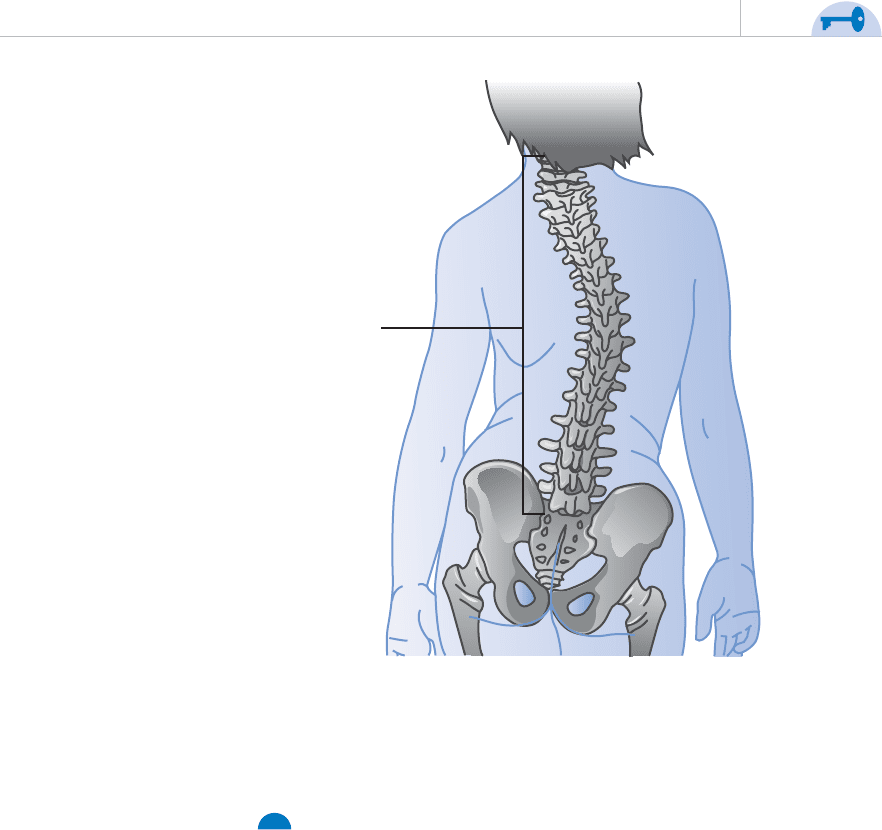Johnson J., Keogh J. Pediatric Nursing Demystified: A Self-Teaching Guide
Подождите немного. Документ загружается.


Signs and Symptoms
䊋 Strain:
• Pain.
• Localized swelling.
• Possibly muscle weakness.
• Severe strain is disabling.
䊋 Sprain:
• Edema
• Pain
• Joint immobility
䊋 Contusion:
• Purple discoloration of the tissue.
• Discoloration fades to brown, yellow, and green as coagulated blood
rises to the upper layers of the skin.
Nursing alert The area of discoloration should decrease as blood coagulates.
Blood disorders and medication may decrease blood coagulation, resulting in
ongoing bleeding from a contusion.
Test Results
䊋 Radiograph: Health-care providers typically order a radiograph to rule
out a fracture.
Treatment
䊋 RICE (rest, ice, compression, and elevation) for 24 to 36 hours follow-
ing the injury. Ice, compression, and elevation reduce inflammation that
causes swelling. Resting the injury reduces pain caused by movement,
encourages healing, and prevents further injury.
䊋 Support the injured extremity to reduce pain caused by movement and
to prevent further injury.
Nursing Intervention
䊋 Contusion:
• Encircle the area of the contusion with a pen and label it with the
date and time to document the size of the contusion.
• Monitor the contusion frequently during the first hour to assess if
the blood has coagulated.
䊋 Assist patient with activities of daily life to reduce pain caused by move-
ment and to prevent further injury.
䊋 Teach the patient and parents:
• The nature of the injury.
• How the treatment will help heal the injury.
2
Pediatric Nursing Demystified
282

FRACTURE
What Went Wrong?
A fracture is the separation of bone. The degree of the separation depends on
the strength of the bone and energy of events that caused the fracture. Frac-
tures are classified in four categories:
䊋 Complete: The bone separates into two distinct parts.
䊋 Incomplete: The bone does not separate into two distinct parts.
䊋 Closed (simple): The bone does not break the skin.
䊋 Open (compound): The bone breaks the skin.
There are three types of fractures:
䊋 Hairline: An incomplete fracture.
䊋 Greenstick: An incomplete fracture where the bone is partially broken
resulting in the bone bending like a broken green stick.
䊋 Comminuted: A complete fracture where the bone is broken into sev-
eral fragments.
Nursing alert Fractures heal faster in children than in adults because children
have a thick vascular periosteum, resulting in increased blood flow to the frac-
ture site.
Signs and Symptoms
䊋 Pain
䊋 Deformity
䊋 Edema
CHAPTER 13 / Musculoskeletal Conditions
283
Why is ice placed on the site of a soft tissue injury?
a. Decreased temperature from the ice causes blood vessels to dilate, increasing
blood flow to the site and increasing edema and swelling.
b. Decreased temperature from the ice causes blood vessels to contract, reducing
blood flow to the site and decreasing edema and swelling.
c. Decreased temperature from the ice causes blood vessels to dilate, decreasing
blood flow to the site and decreasing edema and swelling.
d. Decreased temperature from the ice causes blood vessels to contract, decreasing
blood flow to the site and increasing edema and swelling.
Answer:
✔ ROUTINE CHECKUP 2

䊋 Crepitus
䊋 Reduced range of motion
䊋 Unable to bear weight on the injured bone
Test Results
䊋 Radiograph: Confirms the fracture and confirms realignment of the sur-
face area of the bone.
䊋 Decreased hematocrit may indicate blood loss either from the injury or
from surgical reduction of the fracture, if performed. This might result
in low hemoglobin and reduced oxygenation of blood, which might
inhibit tissue repair.
Treatment
䊋 Closed reduction realigns the surface area of the bone by manipulating
the bones or by applying traction to encourage healing.
䊋 Open reduction is a surgical procedure performed when a closed reduction
is not possible or when repair must be made to torn muscle and ligaments
to encourage healing. Pins, screws, plates, or rods might be used to
realign the bone.
䊋 Immobilize the bone to prevent further injury and to keep the bone
realigned.
䊋 Apply traction to realign bones, reduce muscle spasms, and to immobilize:
• Skin traction: Adhesive material, straps, or foam boot are used to
pull the surface of the skin to cause traction on the bone. Types of
skin traction are
䊊
Buck extension: For knee immobilization
䊊
Bryant traction: For hip dysplasia and fractured femur for children
<3 years of age and weighing <17.5 kg
䊊
Russell traction: For fractures of the femur and lower legs
• Skeletal traction: Pins, wires, and tongs are surgically placed in the
bone applying direct traction to the bone. Types of skeletal traction
are
䊊
Skeletal cervical traction (Crutchfield tongs): For cervical spine
injuries.
䊊
Halo traction: For immobilizing the head and neck following a
cervical injury.
䊊
90/90 femoral traction: For femur or tibia fractures.
䊊
Dunlop (sidearm) traction: For humerus fractures where the arm is
suspended.
䊊
External fixators: Pins or wires are transfixed percutaneously to the
extremity.
䊋 Provide adequate fluid to increase hydration and prevent renal calculi
(rare condition for children).
3
Pediatric Nursing Demystified
284

䊋 Attach a sequential pneumatic compression device to the patient’s legs
when the patient is not mobile to prevent stasis of blood in the legs and
to prevent emboli from developing.
Nursing Intervention
䊋 Assess the impact of the fracture on the child’s growth. Fractures to a
child’s epiphysis might impede the child’s growth.
䊋 Frequently assess circulation in the affected limb to ensure that edema
following a fracture does not restrict blood flow to the limb.
䊋 Assess for nerve compression syndrome—pain, tingling, and numbness.
䊋 Assess for compartment syndrome as a result of increased pressure
from edema—pain, pallor, pulselessness, paresthesia, and paralysis.
䊋 Assess for osteomyelitis, which is an infection that might result from an
open fracture or from surgery to reduce a fracture. Signs are irritability,
abrupt fever, lethargy, pain, and warmth.
䊋 Assess for pulmonary embolism resulting from a fat, air, or blood
emboli that occur within the first 24 hours following a fracture. Adoles-
cents are at the greatest risk. Signs are sudden, severe dyspnea and chest
pain.
䊋 Traction care:
• Assess the position and placement of bandages and straps.
• Assess neurovascular status.
• Treat pain.
• Assess the patient’s psychological response to the treatment.
• Assess the pin sites for infection, inflammation, and bleeding.
• Clean the pin site if ordered with a cotton-tipped sterile applicator
soaked with normal saline or saline/hydrogen peroxide solution.
Apply antibacterial ointment if ordered.
䊋 Minimize immobility by performing range-of-motion exercises and
ambulate when possible to prevent loss of muscle strength, impaired
joint mobility, and venous stasis and increased bone catabolism.
䊋 Teach the patient and parents about the fracture and treatment.
Nursing alert Open or remove the cast immediately at the first signs of com-
partment syndrome to prevent tissue damage and necrosis. Elevate the head of
bed, administer oxygen to the patient, and notify the health-care provider at
the first signs of pulmonary embolism.
HIP DYSPLASIA
What Went Wrong?
Hip dysplasia occurs as a result of abnormal development of the hips during
fetal development. There are three categories of hips dysplasia:
4
CHAPTER 13 / Musculoskeletal Conditions
285

䊋 Acetabular dysplasia (preluxation): The acetabulum is shallow and dish
shaped rather than the normal cup shape, indicating delayed acetabular
development. This is the mildest form of hip dysplasia.
䊋 Subluxation: Incomplete dislocation of the femoral head from the
acetabulum. This is the most common form of hip dysplasia.
䊋 Dislocation: The femoral head loses contact with the acetabulum.
This is the most serious form of hip dysplasia.
Signs and Symptoms
䊋 Asymmetry of gluteal and thigh folds due to the dislocation
䊋 Shortened femur due to the dislocation
䊋 Unequal knee lengths when knees are flexed due to the dislocation
Test Results
䊋 Positive Ortolani test administered from birth to 4 weeks of age due to
the dislocation
䊋 Positive Barlow test due to the dislocation
䊋 Limited hip abduction due to the dislocation
Treatment
䊋 Newborn to 6 months of age:
• Place the patient in a Pavlik harness for 3 to 5 months. Legs are
flexed and knees fall outward to place the hips in proper alignment.
䊋 Six to 18 months of age:
• Place the patient in a hip spica cast for 2 to 4 months following sur-
gical realignment of hips. The hip spica cast immobilizes the legs
and knees and holds the hips in proper alignment.
䊋 Older than 18 months of age:
• An osteotomy might be performed to align the femoral head with
the hips.
Nursing Intervention
䊋 Assess the patient for restricted movement and wide perineum and
unequal gluteal and thigh folds.
䊋 Assess the patient for limp or unequal gait.
䊋 If the patient is in a Pavlik harness:
• Examine the skin under the harness three times a day for redness and
skin integrity.
• Don’t apply lotions or powder to the skin.
• Place an undershirt between the skin and the harness.
• Place the diaper under the harness straps.
• Massage the skin once a day to stimulate circulation.
5
Pediatric Nursing Demystified
286

• Ask the health-care provider if the harness can be removed for daily
sponge bathing.
• Teach the parents how to use the harness and care for the patient.
Explain the benefits of the harness and that it is temporary.
䊋 If the patient is in a hip spica cast:
• Assess for compartment syndrome and nerve compression syn-
drome.
• Make sure that the cast near the perineum is clean of fecal matter
and urine.
• Teach the parents how to care for the patient who is in a hip spica
cast. Explain the benefits of the cast and that it is temporary.
CHAPTER 13 / Musculoskeletal Conditions
287
Why place an undershirt between the skin and the Pavlik harness?
a. To keep the skin moist
b. To prevent infection caused by pins of the Pavlik harness
c. To prevent skin abrasions and irritation by the harness
d. To keep the skin clean
Answer:
✔ ROUTINE CHECKUP 3
OSTEOGENESIS IMPERFECTA
What Went Wrong?
Osteogenesis imperfecta is a genetic bone disease characterized by bones frac-
turing easily without any obvious cause. There are four classifications of
osteogenesis imperfecta:
䊋 Type I (most common): Bones fracture easily before puberty.
䊋 Type II (most severe): Severe bone deformity and numerous fractures
resulting in respiratory problems at or shortly after birth resulting in
death.
䊋 Type III: Fractures present at birth and may have healed.
䊋 Type IV: Fractures are greater than type I and occur before puberty.
Signs and Symptoms
䊋 Easy bruising
䊋 Hyperextensible ligaments
䊋 Epistaxis

䊋 Blue sclera
䊋 Fractures occurring for no obvious reason
䊋 Short statue in all but type I
Test Results
䊋 Radiograph: Shows fractures or healed fractures
Treatments
䊋 No known cure
䊋 Physical therapy to strengthen muscles and prevent osteoporosis
Nursing Interventions
䊋 Handle patients gently to prevent fractures and bruising.
䊋 Teach the parents how to care for the patient.
TORTICOLLIS
What Went Wrong?
The sternocleidomastoid muscle is damaged from intrauterine malposition of
the fetus in or from birth trauma resulting in unusual contraction of the ster-
nocleidomastoid muscle causing the head to bend toward the affected muscle.
Torticollis can also occur from trauma not related to birth.
Signs and Symptoms
䊋 Neck is flexed toward the affected sternocleidomastoid muscle.
Test Results
䊋 Decreased range of motion of the head to the unaffected sternocleido-
mastoid muscle
Treatments
䊋 Low-impact neck stretching exercise to strengthen the neck.
䊋 Apply heat to encourage healing.
䊋 Frequent shiatsu massages to relieve tension caused by the contracting
muscle.
Nursing Interventions
䊋 Provide support to the patient’s neck and head.
䊋 Teach the parents how to care for the patient.
SCOLIOSIS
What Went Wrong?
Scoliosis is the lateral curvature of the spine (see Fig. 13-2). The cause is
unknown. There are three types of scoliosis:
Pediatric Nursing Demystified
288

䊋 Dextroscoliosis: Curvature on the right side
䊋 Levoscoliosis: Curvature on the left side
䊋 Rotoscoliosis: Pronounced rotation of the vertebrae
Signs and Symptoms
䊋 Rib hump
䊋 Asymmetric rib cage
䊋 Visible curvature of the spine
䊋 Uneven shoulder
䊋 Uneven pelvis
Test Results
䊋 Radiograph: Shows abnormal curvature of the spine
䊋 Computed tomography (CT) scan: Shows abnormal curvature of the
spine
䊋 Magnetic resonance imaging (MRI): Shows abnormal curvature of the
spine
6
CHAPTER 13 / Musculoskeletal Conditions
289
Spine
FIGURE 13-2

Treatments
䊋 Up to 20-degree curvature: Exercise to enhance muscle tone and posture.
䊋 Between 20 and 40 degree curvature: Apply a brace to maintain curva-
ture.
䊋 Greater than 40 degree curvature: Spinal fusion surgery.
Nursing Interventions
䊋 If spinal fusion surgery is performed:
• Use log rolling to reposition the child every 2 hours to inhibit devel-
opment of pressure sores and to adequately inflate lungs.
• Monitor vital signs following surgery.
• Apply antiembolism stockings while the patient is on bed rest.
Remove the antiembolism stocking for 1 hour three times a day.
• Assess the patient’s pain level.
• Assess for Homan sign for signs of an embolism.
• Measure the circumference of the calf frequently if the calf is
swollen to determine if there are changes to the swelling.
• Assess for ischemia: Pain, pallor, pulselessness, paresthesia, paral-
ysis.
䊋 Support the back, feet, and knees with pillows when the patient lies on
the side.
䊋 Perform range-of-motion exercises to maintain muscle tone.
䊋 Avoid twisting or turning the spine when moving the patient.
䊋 Explain that spinal fusion surgery stabilizes the spine by inserting wires
and rods into the spine to align the spine permanently.
䊋 Teach the parents the importance of performing ordered exercises and
the need for the patient to wear the brace.
SLIPPED CAPITAL FEMORAL EPIPHYSIS
What Went Wrong?
The upper end of the femur becomes dislocated during the onset of puberty
due to weakness of the epiphysis and a growth spurt. There are four types of
slipped capital femoral epiphysis:
䊋 Acute: Caused by trauma.
䊋 Chronic: Caused by a growth spurt.
䊋 Stable: The patient can walk.
䊋 Unstable: The patient is unable to walk.
Signs and Symptoms
䊋 Visible limp.
䊋 Groin pain.
䊋 Knee, hip, or thigh pain.
䊋 Patient holds hip in the external rotation while at rest.
Pediatric Nursing Demystified
290

Test Results
䊋 Radiograph: Dislocation displayed on radiography
Treatments
䊋 Traction prior to surgery to immobilize the femur
䊋 Surgical realignment using threaded screws to stabilize the joint
Nursing Interventions
䊋 Range-of-motion exercise following surgery to maintain muscle tone
䊋 Traction care:
• Assess the position and placement of bandages and straps.
• Assess neurovascular status.
• Treat pain.
• Assess the patient’s psychological response to the treatment.
• Assess the pin sites for infection, inflammation, and bleeding.
• Clean the pin site if ordered with a cotton-tipped sterile applicator
soaked with normal saline or a saline/hydrogen peroxide solution.
Apply antibacterial ointment if ordered.
䊋 Teach the patient and parents about the dislocation and treatment.
OSTEOMYELITIS
What Went Wrong?
Osteomyelitis is an infection of the bone or bone marrow commonly caused
by Staphylococcus aureus bacteria related to a skin infection, otitis media, or
an upper respiratory infection.
Signs and Symptoms
䊋 Irritability
䊋 Abrupt fever
䊋 Lethargy
䊋 Pain
䊋 Warmth
䊋 Rapid pulse
䊋 Swelling over affected area
Test Results
䊋 Increased white blood cell count.
䊋 Culture and sensitivity test to identify the bacteria and antibiotic.
Treatments
䊋 Prolonged intravenous antibiotic therapy using nafcillin or clindamycin
䊋 Physical therapy to restore muscle tone once the infection is reduced
CHAPTER 13 / Musculoskeletal Conditions
291
